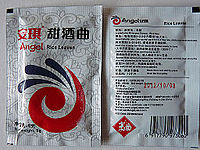
Photo from wikipedia
BACKGROUND There were significant changes occurred in Daqu bricks on the 15th day of incubation and the colors of bricks (yellow, brown, and dark) were generally used as one of… Click to show full abstract
BACKGROUND There were significant changes occurred in Daqu bricks on the 15th day of incubation and the colors of bricks (yellow, brown, and dark) were generally used as one of the standards for the quality evaluation by experienced workers. This study aimed to explore basis behind the phenomenon by multi-omics studies. The physicochemical properties of different high-temperature Daqu were compared. Furthermore, PacBio sequencing and UHPLC-QE-MS approach was employed to analyze the differences in the microbiome and metabolome among different Daqu. RESULTS Bacillus was the biomarker of yellow Daqu, Thermoactinomyces and Thermoascus were the key genera in brown Daqu, and Burkholderiales, Sphingomonas, and Ralstonia were biomarkers in dark Daqu. The physicochemical characteristics (especially the color values) of different high-temperature Daqu, showed strong correlations with the bacterial alpha diversity and the relative abundance of bacterial dominant genera. Amino acid metabolism pathways including tryptophan metabolism, beta-alanine metabolism, and arginine biosynthesis were the key factors resulting in the characteristic differences where Bacillus, Burkholderia, Ralstonia, and Sphingomonas were pivotal bacterial genera. The relative abundance of Bacillus had a positive correlation with the content of 3-hydroxykynurenamine, L-glutamic acid, and pantothenic acid while it showed a negative correlation with indoleacetic acid, L-tryptophan, N-acetylserotonin, L-histidine, L-aspartic acid, phosphatidylserine, 5-methoxyindoleacetate, and L-serine. Burkholderia, Ralstonia, and Sphingomonas had the opposite effects. CONCLUSION Microbes played different roles in amino acid metabolism pathways, resulting in the production of different metabolites, which contributed to the differences in Daqu appearance and quality. This article is protected by copyright. All rights reserved.
Journal Title: Journal of the science of food and agriculture
Year Published: 2022
Link to full text (if available)
Share on Social Media: Sign Up to like & get
recommendations!